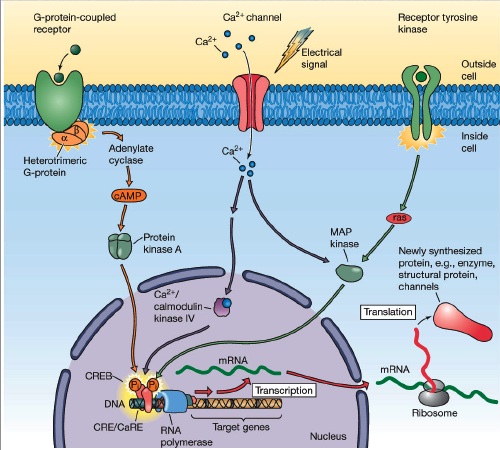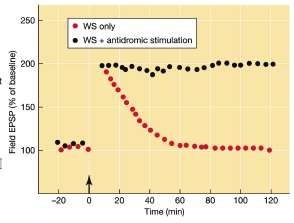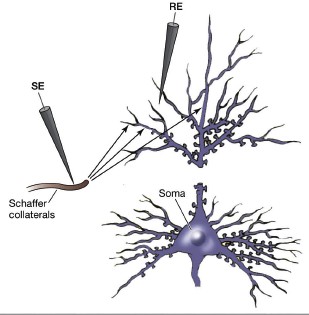Cards In This Set
| Front | Back |
|
What are the differences between short lasting LTP (S-LTP or early LTP) and long lasting LTP (L-LTP or late LTP)?
|
Early LTP is induced by weak high-frequency stimulation and is caused by post-translational modifications (e.g. AMPA receptor trafficking). Late LTP is induced by strong high-frequency stimulation and involves new protein synthesis.
|
|
What is the difference between transcription, translation, and post-translation?
|
Transcription: creating new mRNAs from DNA
Translation: ribosomes read the mRNAs and form a polypeptide chain that folds into proteins Post-translation: modifications that occur after the protein is made (e.g. phosphorylation, ubiquitination, methylation) |
|
Describe the genomic signaling hypothesis.
|
Synaptic activity from the high-frequency stimulation will activate signaling molecules that move to the nucleus and phosphorylate transcription factors (CREB), resulting in new protein synthesis.
|
|
What is a transcription factor?
|
TFs are proteins that bind to specific sequences in DNA and control the rate of transcription.
|
|
What is CREB? How is it activated?
|
CREB stands for cAMP Response Element Binding protein. It is activated by phosphorylation and binds to the CRE sequence of DNA.
|
|
Why do we believe CREB is involved in L-LTP?
|
If you knock out or inhibit CREB (or its phosphorylation), you don't get L-LTP.
|
|
What is the difference between synapse-to-nucleus and soma-to-nucleus signaling?
|
Synapse to Nucleus: mediated by synaptic activity
Soma to Nucleus: mediated by action potentials |
|
How can synaptic activity signal the nucleus to generate new plasticity products?
|
 See pic (too lazy to type out) |
|
Describe the Dudek and Fields experiment that supports the soma-to-nucleus hypothesis? Why might it also be considered an example of synaptic tagging?
|
 Weak Stimulation alone itsn't not enough to induce L-LTP, but weak stimulation plus antidromic stimulation (action potential in axon), will induce L-LTP |
|
Why do we believe that L-LTP depends on protein synthesis?
|
Add a translation inhibitor (anisomycin or emetine) and block L-LTP
|
|
What basic evidence supports the idea that E-LTP has different molecular requirements than L-LTP?
|
Adding actinomycin-D (general transcription inhibitor) before stimulus that can induce LTP will block the long-lasting component but not the short one.
|
|
What is local or dendritic protein synthesis?
|
Free-floating mRNAs already in vicinity of dendrites are translated.
|
|
Defend or reject the following statement: In principle, it is possible that synaptic activity could generate two distinct waves of protein synthesis that could contribute to the support of long-lasting LTP.
|
There can be a wave of protein synthesis at the dendrite that occurs earlier before genomic signalling ushers in another wave.
|
|
Describe the Kang and Shuman experiment and how it illustrates the role of local protein synthesis.
|
 1. Separate dendrites from soma 2. Stimulate Schaffer Collaterals 3. Can still be L-LTP 4. Proteins translated locally in dendrite |
|
Briefly describe how Bradshaw et al. reached the conclusion that protein synthesis occurs in dendrites.
|
Added emetine to:
Apical dendrites = only block L-LTP @ apical dendrites Basal dendrites = only block L-LTP @ basal dendrites Soma = didn't block L-LTP |



